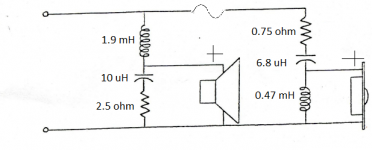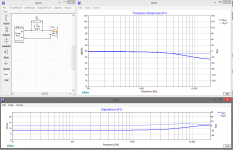Hi everyone. I recently receive a pair of xxx speakers. I have a little bit trouble with their sound. Although I love their bass and upper mid, I don't much like their high. I think the tweeters are running too hot. I can hear "s", "t", "sh", "ch" so much. First, I try to reduce the tweeter level by replacing fuse of tweeter to a resistor (see attachment for x-over schematic). Since they are 2-way speakers with crossover point at 1.5 kHz, the uppder mids are also reduced when reducing tweeters level. I think the L-Pad circuit won't work in my case. Now I need an advise on how to reduce only the upper treble. What on my mind are the choices between 1) Adding a low pass filter on tweeter. As seen the ADS/Braun atelier amplifier, it has a hi-cut button which indicates a 7.5kHz point. So, thing I may have to do is to put 7.5 kHz filters to them. 2) I've heard that the zobel network on tweeter may help to smoothen the high frequency. I'm not sure wherther it's true? Please help me.
Attachments
Last edited:
Place a CR across the tweeter. Being sibilance is the issue, I'd start with a 3.3uF and 6 ohm resistor. Don't go below 4 ohms to keep impedance happy and reduce problem sound further. Cap should not be larger than 4.7uF.
Later,
Wolf
Later,
Wolf
Place a CR across the tweeter. Being sibilance is the issue, I'd start with a 3.3uF and 6 ohm resistor. Don't go below 4 ohms to keep impedance happy and reduce problem sound further. Cap should not be larger than 4.7uF.
Later,
Wolf
Thanks for the help. Could you please inform me where do the 3.3uF and 6 ohm resistor come from? Do they conjectured for the starting point or calculated value for these tweeters?
They come from experience. You will have to play with the values to give the results you want, but the starting point is stated with a hard stop set of limits.
Lower value R gives more cut, 4-8 ohms range.
Larger C value lowers the point at which the change starts, 4.7-1.5uF range.
I recommend 3.3uF and 6 ohms. The 3.3 should be large enough to start below the 7-8kHz sssibilance range without losing detail or making it dull. If you want more cut change to 4 ohms but no lower. My default use for tilt in a rising tweeter tends to be 2.5uF and 4 ohms, but your goal is different.
For another idea- I had a really well done system that was very flat and consisted of a 3rd order filter. I had a 4.7 and 5.6 set of caps and still had a small amount of sibilance, not unlike your example. When I dropped the 4.7uF to a 3.3uF, it placed the droop in the right place and I no longer had the problem. Being that the tweeter is playing lower in your case than in mine, this likely will not work as well for this situation.
Like I said though- this is from experience, and has been used many times by myself.
Later,
Wolf
Lower value R gives more cut, 4-8 ohms range.
Larger C value lowers the point at which the change starts, 4.7-1.5uF range.
I recommend 3.3uF and 6 ohms. The 3.3 should be large enough to start below the 7-8kHz sssibilance range without losing detail or making it dull. If you want more cut change to 4 ohms but no lower. My default use for tilt in a rising tweeter tends to be 2.5uF and 4 ohms, but your goal is different.
For another idea- I had a really well done system that was very flat and consisted of a 3rd order filter. I had a 4.7 and 5.6 set of caps and still had a small amount of sibilance, not unlike your example. When I dropped the 4.7uF to a 3.3uF, it placed the droop in the right place and I no longer had the problem. Being that the tweeter is playing lower in your case than in mine, this likely will not work as well for this situation.
Like I said though- this is from experience, and has been used many times by myself.
Later,
Wolf
to do it right, you would have to measure (frequency and impendance) it, but a inductor bypassed with a resistor creates the kind of filter you need i think. This is a theorethical example of what it could be (values depend on your speaker).
Attachments
yes, that is true, but a coil based filter works better for this application, and the price for this kind of aircoils of values in hifi speakers wattage is at most arround 5€ (depending on the wattage of the tweeter), a cap of that value you say, of a good kind (MKP or PP film) will maybe cost slightly less, but not that much. I would rather use those type of correction (CR parrallel) networks a bit lower in frequency range where they are more effective and the price of the needed coil is much higher.
Hi everyone. I recently receive a pair of ADS L620 speakers. I have a little bit trouble with their sound. Although I love their bass and upper mid, I don't much like their high. I think the tweeters are running too hot.
Judging from the schematic you published, the first thing I would try is replacing that .75 ohm resistor in the tweeter circuit with something of a higher value, maybe 1.5 or 2 ohms. You may have to work up by steps until you get it where you want it.
You could also install an LPAD, as a tweeter level control... making it adjustable when and as needed.
Judging from the schematic you published, the first thing I would try is replacing that .75 ohm resistor in the tweeter circuit with something of a higher value, maybe 1.5 or 2 ohms. You may have to work up by steps until you get it where you want it.
You could also install an LPAD, as a tweeter level control... making it adjustable when and as needed.
I’ve already tried to change the resistance by replacing fuse with a resistor, it series with .75 ohm resistor. I found that they dropped all frequency of tweeters from 1.5kHz. The sound became dull with more than 2 ohms resistor and not enough attenuate with less than 2 ohms (sibilance still occurred). So I came here to ask for another ways.
- Home
- Loudspeakers
- Multi-Way
- Treble reduction circuit

